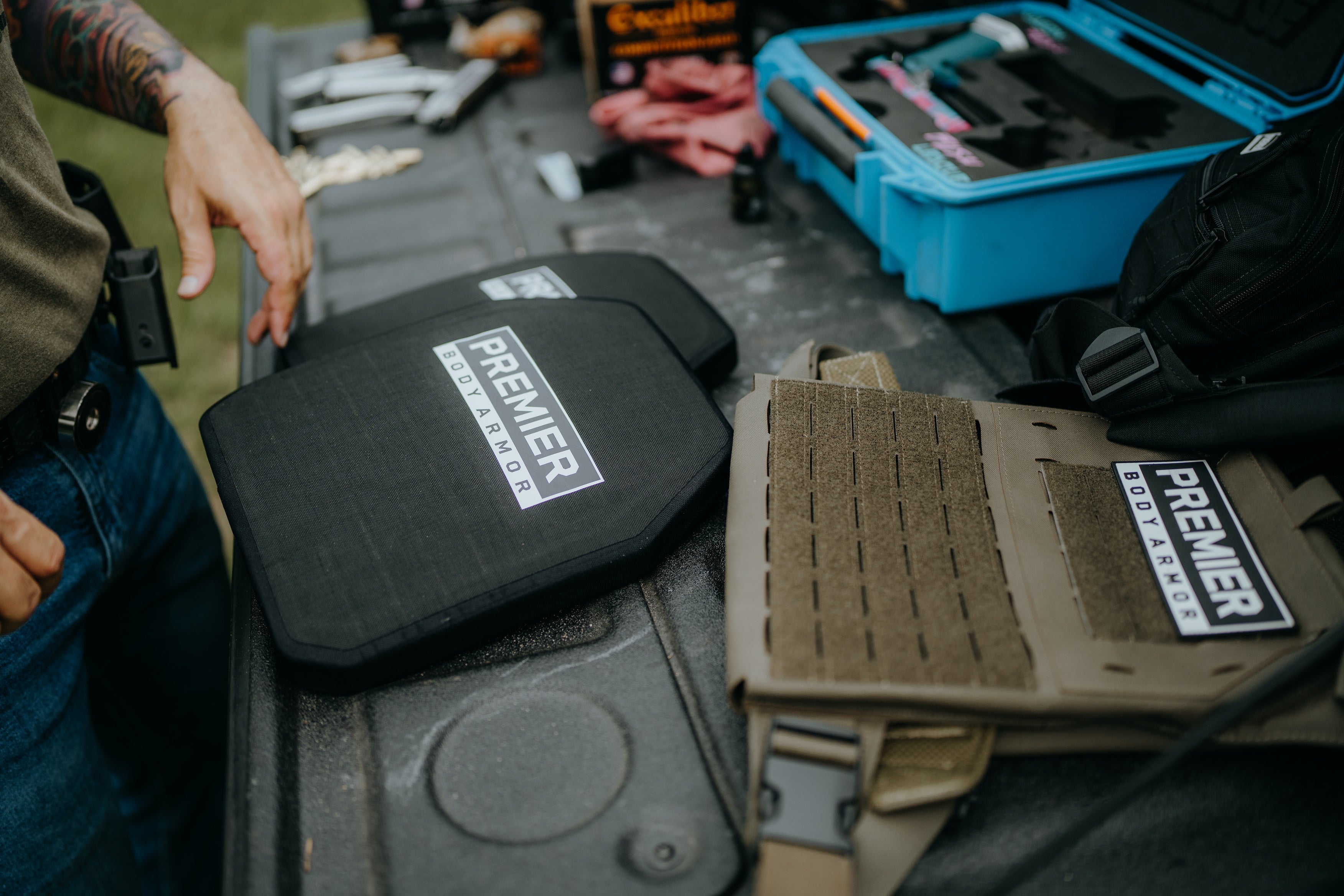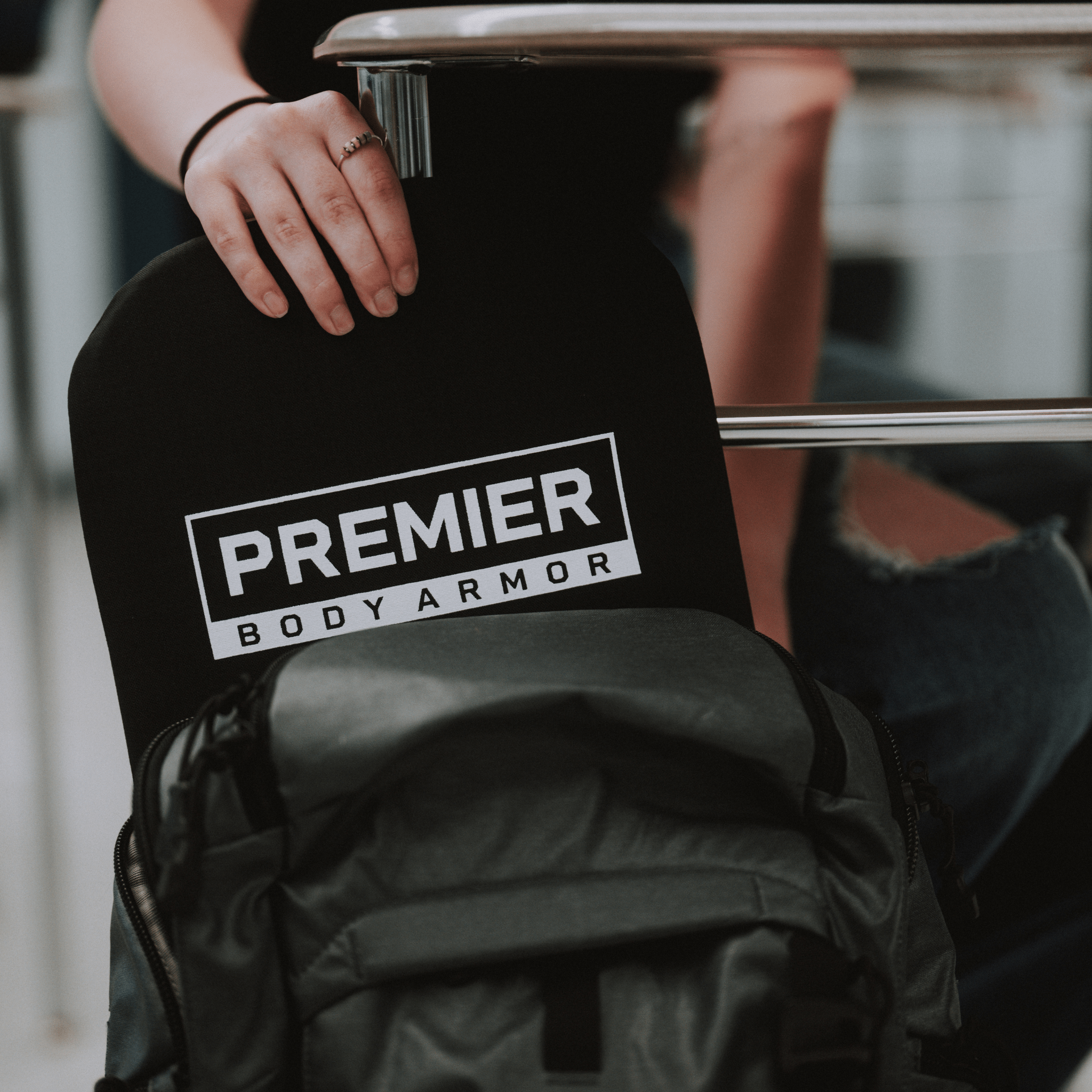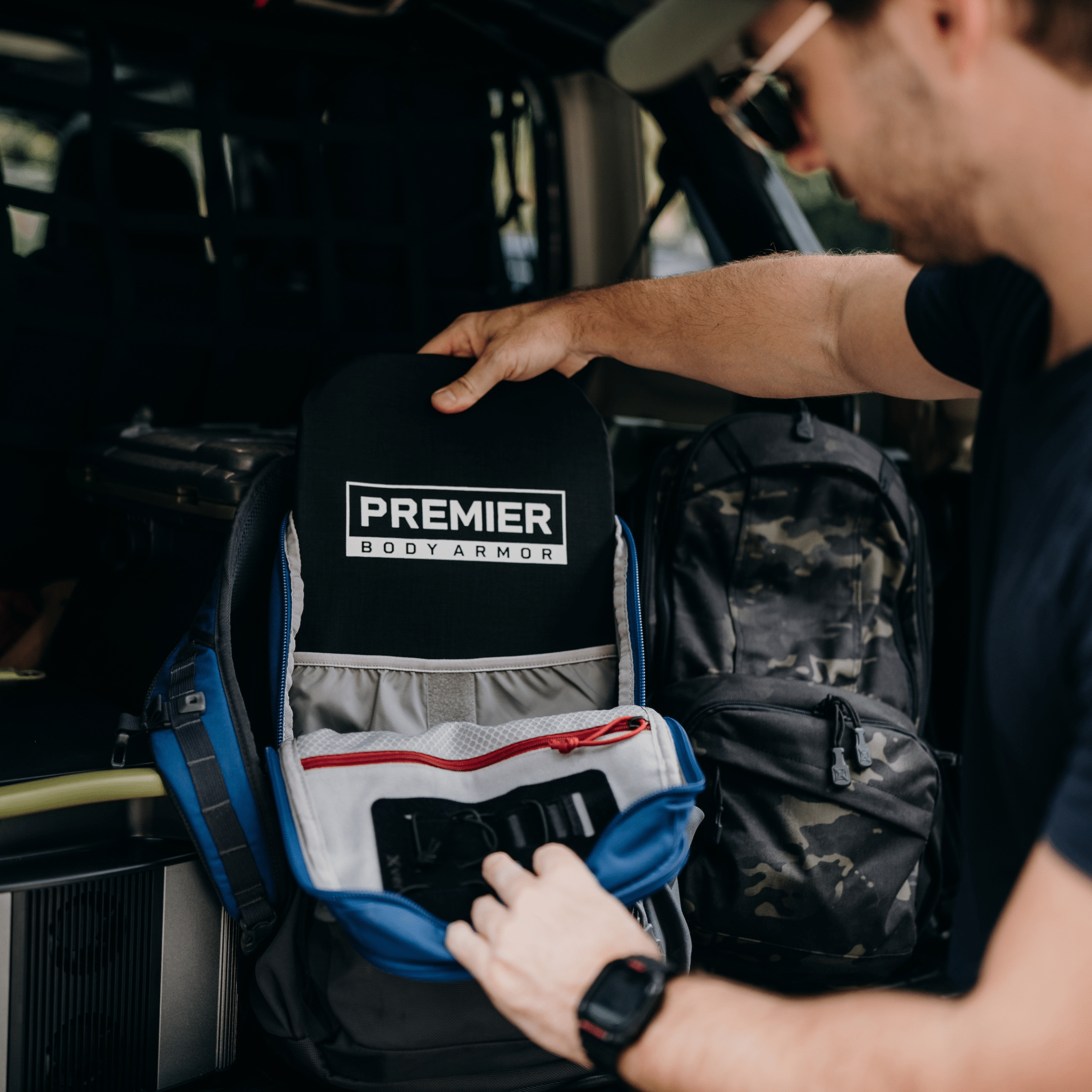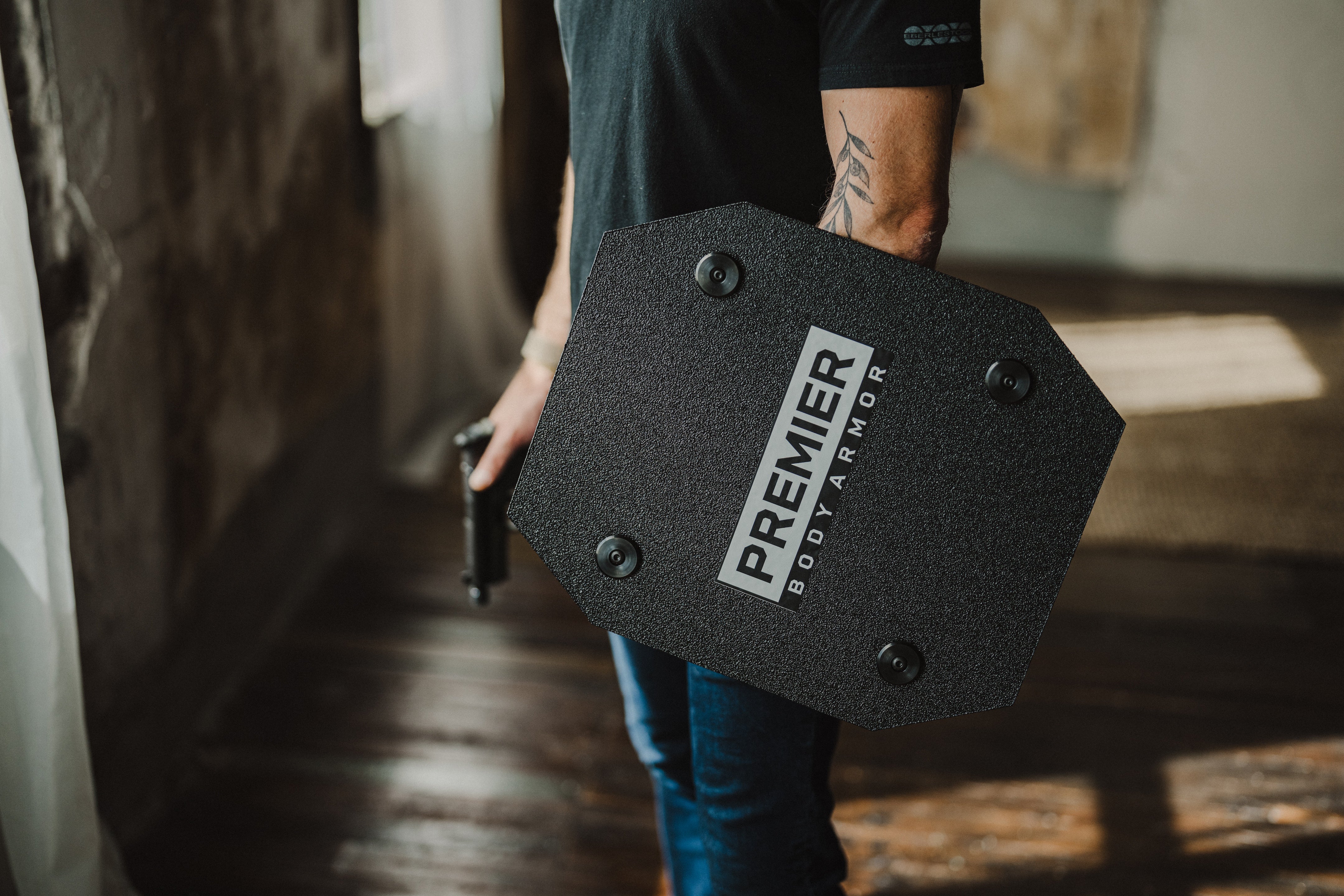Polyethylene Body Armor: The Pros & Cons to PE Ballistic Plates
What is Polyethylene Armor?
Polyethylene (PE) body armor plates, also known as UHMWPE ballistic plates, are lightweight yet highly durable, making them a preferred option for law enforcement, military, and security professionals.
Unlike traditional steel or ceramic armor, polyethylene ballistic plates leverage high-density polyethylene fibers that are layered and compressed to create a strong, impact-resistant structure. This advanced body armor technology provides multi-hit protection while maintaining superior mobility and comfort.
It's important not to confuse polyethylene armor plates with polyurethane materials commonly used in costumes or non-ballistic applications. Throughout this article, we’ll explore the key advantages and drawbacks of PE armor plates, how it compares to other materials, and why it's an excellent choice for modern tactical applications.
Pros of Polyethylene Body Armor
In recent years, polyethylene body armor plates have become the preferred choice for security personnel, law enforcement officers, and military professionals. The rise in popularity is due to UHMWPE armor's lightweight, high strength, and superior durability, making it a leading alternative to Kevlar® and steel body armor. Let’s break down the most important benefits.
Lightweight Yet Strong: Polyethylene plate armor is among the lightest hard armor options available. With an exceptional strength-to-weight ratio, UHMWPE armor plates reduce fatigue, allowing wearers to move freely without compromising protection. For those who need all-day wear, PE body armor significantly cuts down on strain, unlike traditional steel armor.
Resistant to Water & Corrosion: Unlike steel body armor, which is prone to rust and corrosion over time, polyethylene armor is waterproof. This makes UHMWPE ballistic plates ideal for high-humidity environments, maritime operations, or prolonged field use without the risk of material degradation.
Cons of Polyethylene Body Armor
While UHMWPE ballistic plates offer exceptional weight savings and protection, there are a few trade-offs to consider before choosing polyethylene armor.
Heat Sensitivity & Extreme Temperatures: Polyethylene armor remains structurally sound under most conditions but can start softening at prolonged exposure above 180°F (82°C). To ensure long-term effectiveness, avoid prolonged storage in vehicles or direct heat sources above 200°F (93°C). UHMWPE’s melting point is approximately 265°F (129°C), but its ballistic integrity declines before reaching this temperature. This can be mitigated with proper plate storage.
Higher Cost Compared to Steel or Ceramic: UHMWPE body armor is more expensive than steel armor due to advanced material processing and manufacturing costs. However, its long-term durability, lightweight benefits, and lack of corrosion risk make it a worthy investment for those seeking high-performance ballistic protection.
Increased Thickness: While polyethylene plates are lighter than ceramic and steel plates, they tend to be thicker. This can impact concealability, making them less suitable for low-profile or discreet wear under clothing.
How Does Polyethylene Body Armor Compare To Other Types of Body Armor?
Choosing the right body armor plates is crucial for balancing weight, protection, and mobility. Understanding how polyethylene ballistic plates compare to steel, ceramic, Kevlar®, and soft armor helps in making an informed decision.
Below, we break down the pros and cons of polyethylene armor vs. other common body armor materials so you can setup your plate carrier with plates that work for you.
Polyethylene Body Armor vs Steel Body Armor
- Steel armor offers edge-to-edge protection, meaning every inch of the plate stops bullets.
- However, steel plates create dangerous spalling (bullet fragmentation that can injure the wearer) unless coated with anti-spall layers or covered with a spall liner.
- UHMWPE ballistic plates are 50-60% lighter than steel, reducing fatigue.
- Polyethylene armor absorbs impact rather than deflecting it, preventing secondary injuries.
Polyethylene Body Armor vs Ceramic Ballistic plates
- Ceramic body armor is cheaper but are brittle and prone to cracking after impact.
- UHMWPE plates can withstand multiple hits, whereas ceramic armor degrades with each bullet impact.
- PE plates are more durable, making them a better investment for long-term use.
Polyethylene Body Armor vs Kevlar Body Armor
Polyethylene body armor and Kevlar body armor are both highly effective and durable materials. Kevlar® contains synthetic fibers that feel more more like thick clothing.
- Kevlar® soft armor is effective against handguns, while polyethylene rifle plates stop rifle rounds.
- Kevlar® is thinner and more concealable, but UHMWPE plates provide superior rifle protection.
Polyethylene Body Armor vs Soft Body Armor
- Soft armor, like Kevlar®, is lightweight and flexible, but does not protect against rifle threats.
- Polyethylene body armor is designed for high-threat environments requiring rifle-rated protection.
Despite its impressively low weight, polyethylene armor isn’t as discreet as most soft body armor due to its increased thickness.
Polyethylene Body Armor vs Hard Body Armor
- Hard armor includes steel, ceramic, and polyethylene plates.
- UHMWPE ballistic plates are the lightest hard armor option, combining high-level protection with comfort.
| Feature | Polyethylene | Steel | Ceramic | Soft Armor (Kevlar®) |
|---|---|---|---|---|
| Weight | Lightest hard armor option | Heaviest | Moderate | Lightest overall |
| Protection Level | Rifle-rated (Level III & IV) | Rifle-rated (Level III+) | Rifle-rated (Level III & IV) | Handgun-rated (Level II & IIIA) |
| Durability | Long-lasting, resistant to moisture | Most durable, but can rust | Brittle, cracks easily | Flexible but can degrade over time if worn frequently |
| Heat Resistance | Sensitive to extreme heat | Excellent | Good | Good |
| Cost | Moderate to High | Budget-friendly | Moderate | Varies (Low-Moderate) |
| Spalling Risk | None | High (requires anti-spall coating) | None | None |
Choosing the right body armor depends on your specific needs:
- Polyethylene plates offer the best combination of weight, protection, and durability, making them ideal for law enforcement, security professionals, and anyone seeking rifle-rated protection without excessive weight.
- Steel armor is the most budget-friendly, but its heavy weight and risk of spalling make it less ideal for prolonged wear.
- Ceramic plates offer solid protection but can crack after impact, making them less durable for multiple threats.
- Soft body armor (Kevlar®) is the best option for day-to-day wear and concealability, but it is not rifle-rated.
For those prioritizing lightweight protection with high ballistic resistance, polyethylene body armor is the clear winner. If you're on a budget and need rifle-rated armor, steel may be a reasonable alternative—but keep in mind its weight and spalling risks. If discreet protection against handguns is the priority, soft armor is an excellent choice.
Why You Should Consider Lightweight Polyethylene Armor
When choosing body armor, striking the right balance between weight, protection, and comfort is crucial. Polyethylene armor stands out as the best lightweight option for those seeking rifle-rated defense without the burden of heavier materials like steel or ceramic. Here’s why:
Ultra-Lightweight Construction: Polyethylene plates are up to 60% lighter than steel or ceramic plates, significantly reducing fatigue for law enforcement, security professionals, and military personnel who wear armor for extended periods. Our Stratis Level III+ Multi-Curve plate is the lightest option at just 3lbs.
High Protection Levels: Despite their lightweight build, UHMWPE plates meet NIJ Level III and IV standards, stopping powerful rifle rounds without excessive bulk. They also feature multi-hit capability, ensuring continued protection even after multiple impacts.
Unmatched Comfort & Mobility: The reduced weight and shock-absorbing structure of polyethylene plates allow for quicker movement and easier maneuverability—a critical factor in high-stress tactical situations.
Durability & Environmental Resistance: Unlike steel, polyethylene armor won't rust or corrode, and it is highly resistant to moisture, making it perfect for humid, maritime, or wet environments. Unlike ceramic, polyethylene plates won’t shatter upon impact, ensuring consistent protection.
Bottom Line: If you want the most comfortable, durable, and lightweight rifle-rated protection, polyethylene armor is the best choice.
We offer poly plates level 3 as well as our level 4 polyethylene body armor. Different situations require different levels of protection. Learn more about body armor ratings to find out which treat level of protection is best for you.
How is Polyethylene Body Armor Made?
The process of creating polyethylene body armor is highly specialized, combining advanced engineering, heat compression, and ballistic science to produce lightweight yet incredibly strong protective plates. Here’s how it's done:
1. Producing UHMWPE Fibers:
- Ultra-High Molecular Weight Polyethylene (UHMWPE) starts as ethylene molecules, which undergo gel-spinning, creating long, high-strength fibers.
- These fibers are stretched and aligned, increasing their tensile strength to make them bullet-resistant.
2. Weaving & Layering the Fabric:
- The fibers are woven into multiple layers, forming a fabric capable of dispersing impact energy across a broad surface.
3. Heat & Pressure Lamination:
- Under intense heat and compression, the woven UHMWPE sheets are bonded into solid armor plates.
- This fusion process enhances ballistic resistance and prevents fragmentation upon impact.
4. Precision Cutting & Shaping:
- The hardened polyethylene panels are cut into specific armor shapes (SAPI, Shooter’s Cut, Swimmer’s Cut, etc.).
- The plates are contoured to fit comfortably against the body without restricting movement.
5. Final Assembly & Protective Coating:
- Polyurea coating is applied to increase durability, resist moisture, and reduce backface deformation. You may also see plates wrapped in Cordura for durability.
- The result? Lightweight, rifle-rated armor that outperforms traditional materials in weight and resilience.
Why Does This Matter? Unlike steel or ceramic plates, polyethylene absorbs and distributes impact energy instead of breaking or ricocheting rounds. This process makes it one of the most effective, long-lasting, and advanced armor materials available today.
What You Need to Know About Ultra-High Molecular Weight Polyethylene Armor
When selecting UHMWPE (Ultra-High Molecular Weight Polyethylene) body armor, it’s crucial to evaluate factors beyond protection levels. Polyethylene plates stand out for their durability, multi-hit capability, and lightweight construction, but understanding their limitations and advantages will help you make an informed decision.
This section explores key considerations such as edge-to-edge protection, lifespan, impact resistance, and specialized use cases to ensure you select the best polyethylene armor for your needs.
What About Edge-to-Edge Protection Of Polyethylene Plates?
When shopping for plates, be sure to ask about edge-to-edge protection. You'll find some plates, like our Fortis Level IV plate, has a strike face minimally inset 0.5" to protect against drops, where other plates may have larger insets. You want as close to edge-to-edge protection as possible for the greatest area of coverage.
Regardless of your setup, always ensure your cardiac box (heart and major organs) is fully covered, as this is the most vulnerable and critical area.
What is the Shelf Life of Polyethylene Armor?
How long does polyethylene body armor last? Polyethylene armor typically has a 5-10 year lifespan, depending on manufacturer and storage conditions. Unlike ceramic, which can degrade from impact, polyethylene armor remains effective unless exposed to extreme heat or mechanical damage.
To maximize your armor’s lifespan:
- Store in a cool, dry location away from direct sunlight and extreme heat.
- Avoid moisture buildup to prevent material degradation.
- Check manufacturer guidelines for routine maintenance and testing.
At Premier Body Armor, our polyethylene plates undergo rigorous testing to ensure they meet NIJ standards for long-term durability. Each plate comes not only with a competitive warranty guaranteeing reliable ballistic protection throughout its lifespan, but also with an incident replacement guarantee.
What about PE Plate Backface Deformation?
Backface deformation (BFD) occurs when the force of a bullet impact causes the rear surface of an armor plate to bulge into your body. While some deformation is normal, excessive BFD (over 44mm) can result in serious blunt force injuries.
How do polyethylene plates minimize BFD?
- UHMWPE plates are designed to absorb and disperse impact energy, reducing the severity of backface deformation.
- Thicker polyethylene plates provide superior BFD resistance compared to steel or ceramic plates.
Choosing a thicker polyethylene plate with multi-layered construction can significantly reduce blunt force trauma while still keeping your armor lightweight and comfortable.
Are Polyethylene Rifle Plates Multi-Hit Capable?
Are polyethylene plates multi-hit capable? Some polyethylene plates, like our Fortis Level IV Plate, are engineered for multi-hit protection with a tiled composite strike face that prevents damage from spreading and cracking across the plate. However, not all UHMWPE plates are multi-hit rated—always check testing documents and NIJ certifications for confirmation.
Key Multi-Hit Benefits:
- Tiled Composite Construction: Absorbs and contains damage within localized sections.
- Lightweight Design: Offers high-level protection without excessive bulk.
- Superior Durability: Maintains ballistic integrity even after multiple hits.
While our multi-hit polyethylene plates provide exceptional protection, any armor plate that sustains direct impact should be replaced as soon as possible to ensure continued safety.
Does Polyethylene Body Armor Float in Water?
One of the unique benefits of UHMWPE body armor is its buoyancy—unlike steel or ceramic plates, polyethylene armor plates float in water. This makes them an excellent choice for maritime security personnel, military divers, and rescue operations, where being weighed down by heavy armor could be dangerous.
Key Benefits of Buoyant Polyethylene Armor:
- Does not sink like steel or ceramic armor.
- Ideal for maritime operations or humid environments.
- Maintains ballistic integrity even when wet.
However, while UHMWPE plates are water-resistant and lightweight, they should never be relied upon as a flotation device or life-saving equipment. They are designed for ballistic protection, not water survival.
Is Polyethylene Body Armor Knife Safe / Knife Resistant?
Can polyethylene body armor stop a knife? While UHMWPE armor plates are highly resistant to ballistic threats, they are not rated as fully stab-proof. The woven fibers of polyethylene plates provide some resistance to slashing, but they are not NIJ-rated for stab resistance.
Unlike dedicated stab-proof vests, polyethylene armor does not prevent piercing attacks from knives or other edged weapons.
Key Facts About Knife Resistance & UHMWPE Armor:
- Polyethylene plates may resist slashing attacks but are not tested for direct stab protection.
- "Stab vests" exist, but they are separate from ballistic-rated polyethylene armor.
For dedicated stab-resistant armor, check for NIJ-certified stab-resistant vests specifically designed for bladed threats.
Final Thoughts
The best polyethylene body armor stands out as the lightest rifle-rated protection available today, combining durability, comfort, and mobility without sacrificing ballistic performance. Whether you're in law enforcement, military, or a civilian prioritizing safety, UHMWPE plates offer a practical alternative to heavier steel or ceramic options.
At Premier Body Armor, we offer Level III and Level IV polyethylene body armor engineered for maximum protection and comfort. For those desiring a more covert solution, our polyethylene body armor backpack insert provides rifle-rated protection for most standard sized backpacks.
Learn more about our polyethylene armor collection or explore our full guide to body armor selection to find the right fit for your needs.










Former (2x) OIF VETERAN 3/6 USMC Infantry. First wore interceptor then Modular Tach Vest. Both with front/back side sappi plates. Weight MTV=35lbs plain.
Sappi =(Kevlar+bublewrap+shall+kevlar sandwiched=fragil) claimed up to(3)7.62×39AK w/NO guarantee after (1) round. I bought this product bc of 3rd party independent YouTube analysis. It took as many AK rounds + 7.62×54 & sniper (Russian) with 0 failures. I feel very confident at 1” 1/8 thick & weight 3.3lbs (IV) UHMWPE will stop anything life threatening. It fit into my carrier(just tight & if it ain’t tight-it ain’t right)! Very happy choosing these exact tact plates. Bc my carrier is still heavy but not as much if I went all steel. I feel UHMWPE is the future and I’ve owned mine since 2020 after Bonehead got in, this was new, did research and bought. I paid $400(F/B) each, back then but an investment worth my life. As a former Infantry NCO don’t go cheap when it comes to certain items like this. Less weight & better protection = more mobility+ more protection= mission accomplishment. CPL WJO 3/6 kilo co
Leave a comment